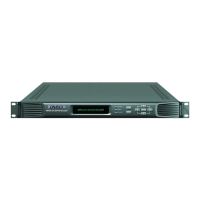
Do you have a question about the Dveo Futura II ASI+IP and is the answer not in the manual?
| Input Interfaces | ASI, IP |
|---|---|
| Output Interfaces | ASI, IP |
| Power Supply | 100-240 VAC, 50/60 Hz |
| ASI Data Rate | Up to 214 Mbps |
| IP Protocols | UDP, RTP |
Details warranty coverage and conditions for free repair.
Lists important safety notices and warnings for product operation.
Provides essential safety precautions for installation and usage.
Lists the history of software revisions and releases.
Outlines conditions for free replacement and exceptions during warranty.
Lists the components included in the product package.
Identifies and describes the controls and indicators on the front panel.
Identifies and describes the ports and connectors on the rear panel.
Illustrates how to connect various input sources and network.
Step-by-step guide for powering the device on and off.
Configuration of video and audio input/output signals.
Setting up IP stream transport, cast type, and target IP.
Setting video encoder type, bit rate mode, and rate.
Adjusting the video aspect ratio for display.
Configuring the Group of Pictures (GOP) structure.
Setting video resolution and frame rate parameters.
Choosing the audio encoding format.
Setting the desired audio encoding bit rate.
Configuring audio input channels.
Adjusting the audio signal output volume.
Setting audio delay for lip synchronization.
Enabling or disabling automatic audio gain control.
Configuring Pass Through Mode for audio.
Setting the audio mix mode (e.g., Stereo 1 CH, Stereo 2 CH).
Setting PSIP/PSI mode, channel number, and name.
Configuring Program Identification (PID) values for streams.
Configuring IP address, subnet mask, and gateway.
Adjusting minimum and maximum latency settings.
Setting the overall bit rate for the device.
Verifying the current software firmware version.
Resetting system data to default values.
Steps for installing and connecting the web controller for device management.
Using the configuration tool to find the device's IP address.
Using the tool to configure network settings and upload firmware.
Accessing and navigating the device's web interface for control.
Configuring system parameters through the web interface.
Configuring video and audio I/O via the web interface.
Adjusting video parameters via the web interface.
Managing audio settings via the web interface.
Configuring PSIP settings via the web interface.
Setting PID values via the web interface.
Checklist for common issues before reporting to support.
Instructions for assembling and connecting Mini XLR cables.
Details on repair services during and after the warranty period.
Disclaimers regarding critical component use in life support or aircraft.
